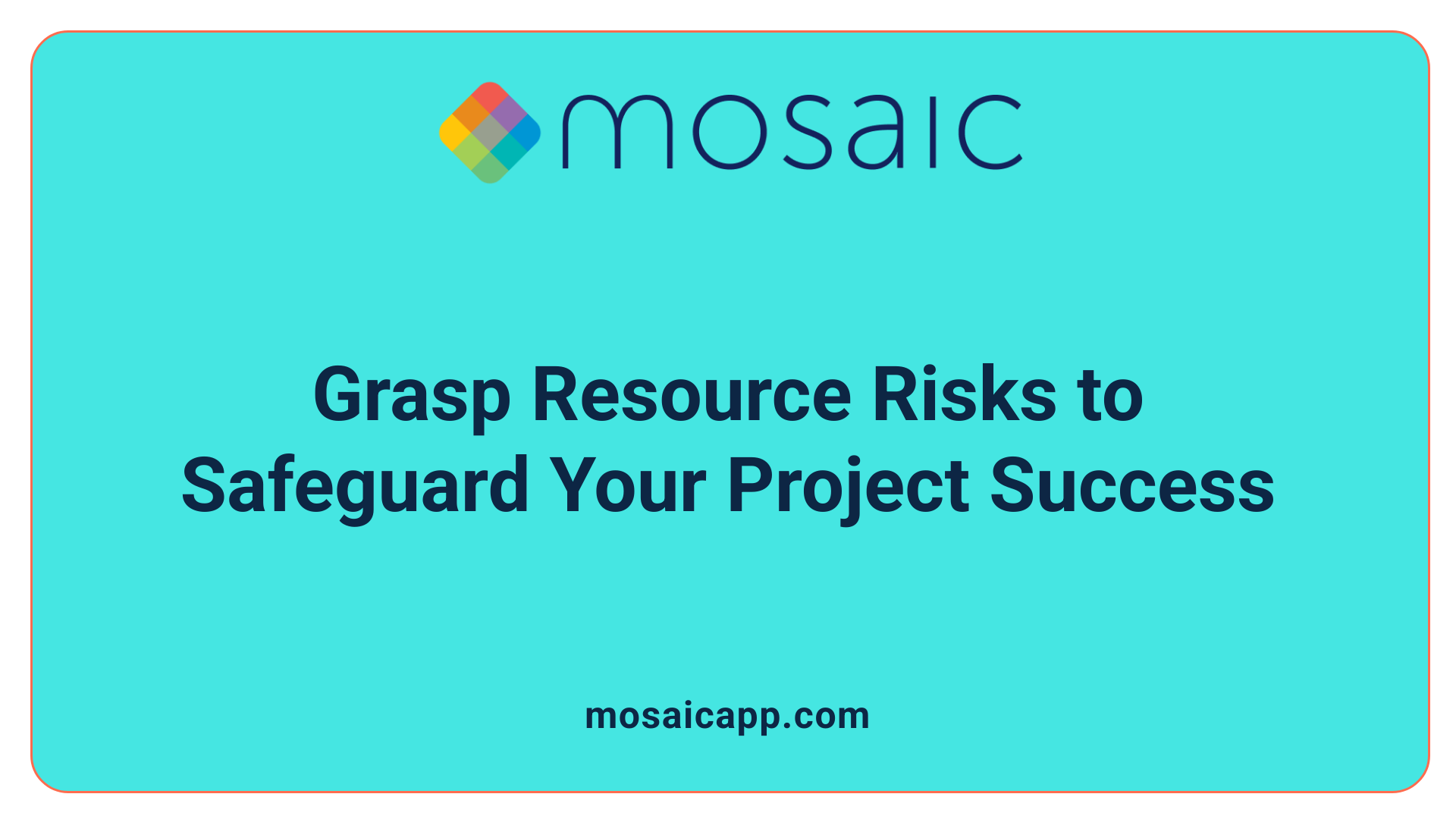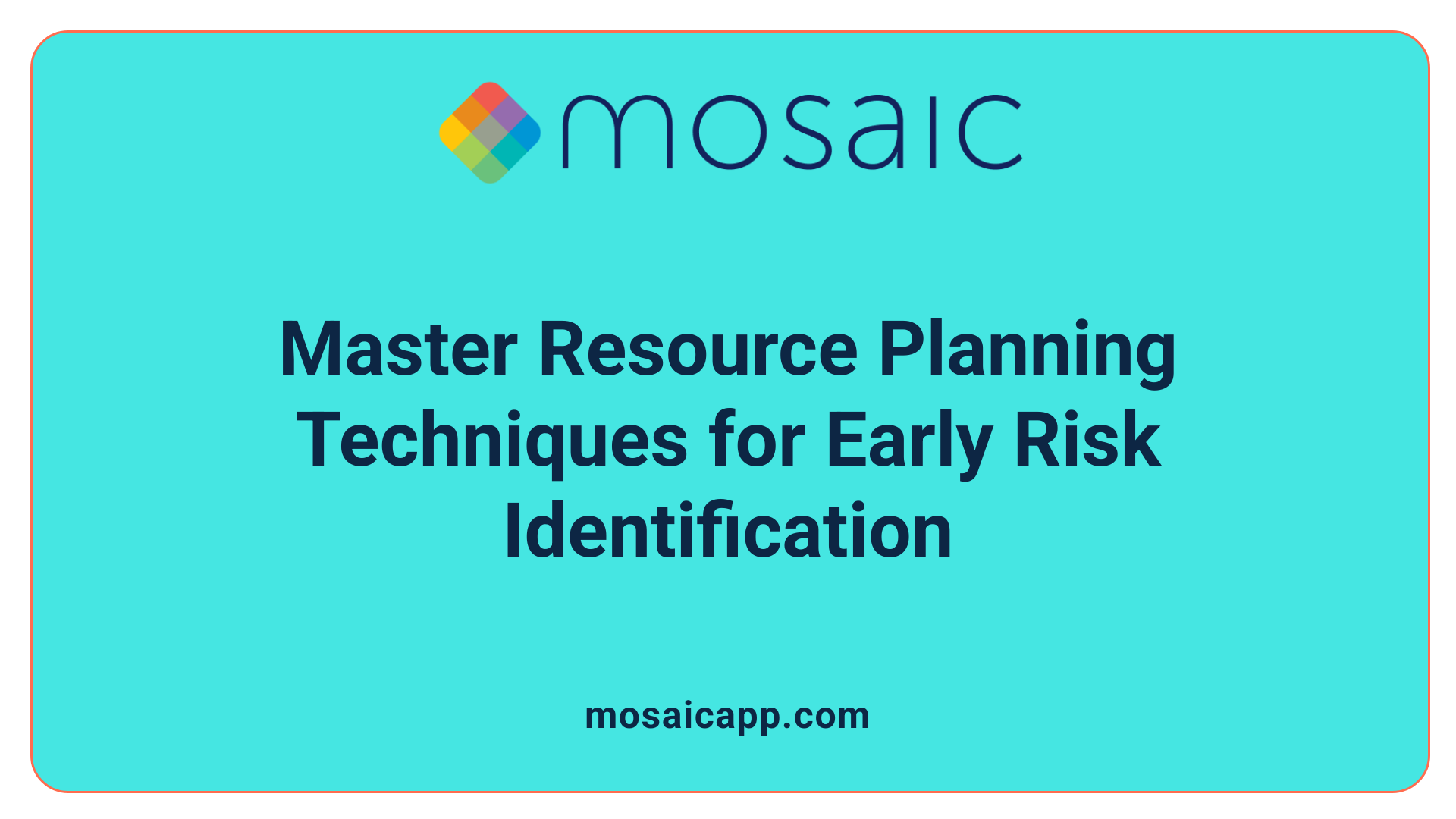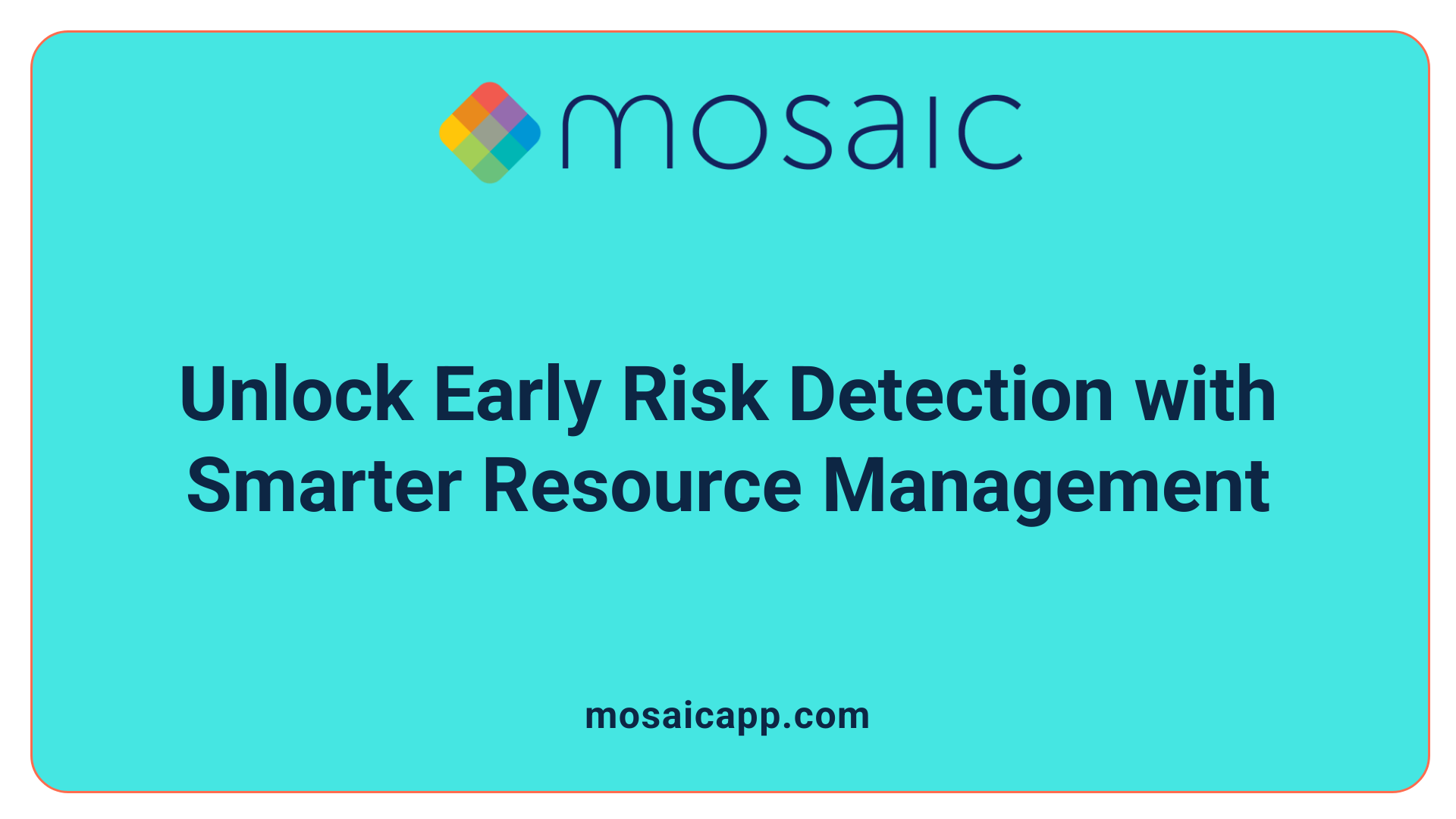Introduction to the Critical Role of Resource Management in Project Risks
Effective resource management is paramount in mitigating project risks early in the project lifecycle. By carefully planning, monitoring, and deploying resources, project managers can identify potential threats and implement strategies to prevent their escalation. This comprehensive overview explores how resource management acts as a foundational tool to minimize risks, improve project outcomes, and enhance overall predictability.
Understanding Resource Risks and Their Impact on Projects

What is the role of resource management in reducing project risks during early project stages?
Effective resource management is crucial for minimizing risks at the beginning of a project. It involves careful planning and the strategic allocation of human, material, financial, and technological assets.
By early identification of resource shortages, skills gaps, and scheduling conflicts, project managers can develop contingency plans, optimize resource deployment, and address potential uncertainties proactively.
Modern resource management tools provide real-time visibility into resource attributes, forecast future needs, and facilitate scenario analysis. These features enable teams to prevent overloading or underutilization, which helps avoid delays and budget overruns.
Consistent monitoring of resources throughout the project lifecycle ensures early detection of issues, allowing for timely adjustments. Creating a resilient resource plan from the start increases project success likelihood and keeps risks in check.
In summary, effective resource management acts as a foundation for risk mitigation, ensuring smoother project execution and higher chances of meeting project objectives.
Strategies and Best Practices in Proactive Resource Risk Mitigation
What strategies and best practices can be used for proactive risk mitigation through resource management?
Effective management of resource risks begins with systematic planning and continuous oversight. One of the fundamental practices involves demand forecasting and capacity planning. By accurately predicting project demands and evaluating available resources, organizations can prevent resource shortages or over-utilization, which can disrupt project timelines and quality.
Real-time monitoring and assessment further enhance risk mitigation efforts. Utilizing modern resource management tools, teams can track resource utilization, competency levels, and scheduling conflicts as they happen. This ongoing oversight allows for early detection of potential issues such as skill gaps, burnout, or bottlenecks, enabling prompt corrective action.
Flexible and multi-skilled resource allocation is another essential strategy. Developing a workforce with diverse skills allows organizations to adapt quickly to changing project needs and reduce dependence on critical resources. Maintaining backup resources and leveraging a talent pool or global resources also ensure continuity when primary resources are unavailable.
Engaging stakeholders early and conducting scenario planning contribute significantly to risk preparedness. Regular risk assessments, facilitated through stakeholder involvement, reveal potential resource constraints under various project scenarios, promoting better contingency planning.
Numerous tools support resource risk mitigation, including competency matrices, dashboards, and predictive analytics. These enable managers to visualize resource attributes, forecast future demands, and simulate different deployment scenarios.
Adopting these practices creates an adaptable and resilient resource management environment, reducing the likelihood of delays, cost overruns, and other project risks. Aligning resource strategies with organizational risk appetite and encouraging continuous improvement fosters sustained project success.
| Strategy | Description | Benefits |
|---|---|---|
| Demand forecasting | Predict future resource needs based on project scope | Prevents shortages, optimizes utilization |
| Capacity planning | Assess current capacity and plan adjustments accordingly | Avoids overloads, ensures availability |
| Real-time monitoring | Continuous tracking of resource metrics | Early detection of issues |
| Multi-skilling | Developing diverse skill sets within staff | Enhances flexibility, reduces bottlenecks |
| Backup resources | Maintaining contingency talent pools | Ensures project continuity |
| Stakeholder engagement | Involving stakeholders in risk assessments | Improves comprehensiveness of plans |
| Scenario planning | Simulating different project outcomes | Better preparedness |
| Advanced tools | Using resource management software and analytics | Visibility and informed decision-making |
Techniques and Processes in Resource Planning for Early Risk Detection

How can techniques and processes in resource planning help identify and evaluate early project risks?
Resource planning techniques and processes are vital tools for detecting potential project risks early in the project lifecycle. By employing structured frameworks such as risk identification workflows and SWOT analysis, project managers can systematically uncover resource-related issues like shortages, skill gaps, or scheduling conflicts.
Diagramming methods, including fishbone diagrams and process flow charts, assist teams in understanding root causes and identifying bottlenecks or inefficiencies that could threaten project progress. Integrating resource planning with scope management using methods such as mapping risks to the Work Breakdown Structure (WBS) allows for a more comprehensive view of potential issues aligned closely with project objectives.
Modern resource management software further enhances early risk detection by providing capabilities like scenario analysis and forecasting. These tools enable teams to model different resource scenarios, evaluate impacts, and develop mitigation strategies proactively. Together, these techniques foster a thorough understanding of resource risks and prepare project teams to address them before they escalate, increasing the likelihood of on-time and within-budget project completion.
The Impact of Effective Resource Management on Early Risk Detection and Minimaization

How does efficient resource management improve early risk detection?
Effective resource management plays a crucial role in identifying potential risks early in the project lifecycle. By providing enhanced visibility into resource attributes such as availability, skills, and capacity through advanced planning and monitoring tools, project teams gain a clearer understanding of their resource landscape.
This transparency enables them to proactively assess potential constraints like skill shortages, over-utilization, or dependency bottlenecks. Recognizing these issues early allows for timely interventions such as workforce training, reallocation, or hiring, which can prevent delays or quality problems down the line.
Why are skills gaps and dependencies important to address early?
Addressing skills gaps and resource dependencies early helps in reducing project uncertainties. When project managers can identify lacking skills or over-reliance on critical resources early, they can implement targeted solutions like upskilling staff or diversifying vendors.
Such strategies ensure continuous workflow without disruptions, decreasing the likelihood of scope creep, increased costs, or schedule delays. Detecting these risks beforehand makes it possible to design contingency plans that keep the project on track.
What strategies support demand forecasting and contingency planning?
Demand forecasting involves estimating future resource needs based on project scope and progress. Techniques like demand gap analysis help determine whether current resources meet upcoming requirements.
Contingency planning prepares alternative pathways to address resource shortages or failures. Strategies include maintaining backup resources, multi-skilling employees, and engaging global vendors to diversify supply sources.
Implementing these proactive measures ensures that resource-related disruptions are minimized, contributing to smoother project execution.
How does modern software aid scenario analysis?
Modern resource management software tools facilitate scenario analysis, allowing project managers to simulate various situations like resource over-utilization, skill shortages, or project scope changes.
Features such as capacity planning, competency tracking, and utilization dashboards enable teams to visualize potential bottlenecks and test solutions before issues become critical. This predictive capability supports informed decision-making and swift course corrections.
What are the benefits of reducing delays, cost overruns, and scope creep?
By actively managing resources and identifying risks early, projects experience fewer delays and stay within budget.
Efficient resource allocation prevents overburdening team members, reducing burnout and lowering employee turnover risks.
Additionally, early risk detection helps limit scope creep by ensuring resources are aligned with realistic project objectives, maintaining quality standards.
Overall, effective resource management leads to more predictable project outcomes, higher stakeholder satisfaction, and increased success rates.
Tools, Methodologies, and Educational Resources for Early Risk Reduction

What tools, methodologies, and educational resources support early risk reduction via resource management?
Reducing project risks early on is essential for ensuring successful outcomes. A variety of tools, frameworks, and training programs play a vital role in identifying potential issues before they escalate.
Project management software and dashboards are fundamental. These digital tools provide real-time visibility into resource allocation, project schedules, and potential bottlenecks. Features like forecasting, scenario analysis, and utilization monitoring enable managers to anticipate resource constraints and adjust plans promptly.
Risk assessment frameworks and templates are structured approaches to evaluate risks systematically. They help categorize risks, estimate their likelihood, and analyze potential impacts. Standardized protocols for risk identification, assessment, and response facilitate consistency and thoroughness. Common tools include risk registers, probability-impact matrices, and decision trees, which prioritize critical risks requiring early intervention.
Educational resources such as specialized training courses and certification programs are crucial for building expertise. Courses like Risk Assessment for National Planning and project management certifications equip participants with skills to recognize, evaluate, and mitigate risks effectively. These programs often include case studies and practical exercises on resource management, preparedness, and resilience strategies.
Early warning systems and mechanisms for risk data collection enhance proactive responses. Multi-hazard early warning systems, supported by standards like the Common Alerting Protocol, allow for timely dissemination of warnings related to natural disasters, economic shifts, or other hazards that could impact project resources.
Moreover, comprehensive risk data collection activities—including regular monitoring, reporting, and analysis—support informed decision-making. These data-driven approaches help detect emerging threats and facilitate swift mitigation actions.
Finally, establishing standardized protocols and effective risk governance practices ensures that organizations are prepared to handle uncertainties systematically. Clear procedures for risk reporting, accountability assignment, and continuous monitoring foster a proactive safety culture.
| Tool/Resource | Purpose | Benefits |
|---|---|---|
| Project Management Software | Resource tracking, scenario planning | Early identification of resource gaps, improved coordination |
| Risk Assessment Frameworks | Risk categorization and analysis | Structured risk evaluation, prioritization |
| Training & Certification Programs | Skills development | Enhanced capacity for risk identification and mitigation |
| Early Warning Systems | Timely alerts on potential hazards | Prompt responses, minimized impact |
| Standardized Protocols | Risk governance | Consistent risk handling, accountability |
Supporting early risk reduction thus involves integrating advanced tools, structured methodologies, and ongoing education to foster resilient project environments capable of anticipating and mitigating potential resource-related issues.
Monitoring and Controlling Risks through Continuous Oversight
How does regular monitoring and control of resource risks contribute to project success?
Ongoing tracking of resource risks ensures that potential issues are identified early, allowing teams to respond proactively. Regular updates to risk logs and consistent project meetings keep risk information current, fostering transparency and awareness among all stakeholders.
Designated risk owners play a crucial role by being responsible for managing specific risks, which improves accountability and ensures timely mitigation efforts.
Utilizing dashboards and real-time reporting tools provides clear visualization of resource status and emerging risks, facilitating swift decision-making.
Throughout all project phases, continuously reviewing and adjusting mitigation strategies helps address new challenges without causing delays or escalating problems. This adaptive approach maintains project momentum and enhances the chances of delivering within scope, time, and budget.
By embracing vigilant risk oversight, project teams can prevent minor setbacks from becoming major issues, ultimately supporting successful project delivery and greater stakeholder satisfaction.
Integrating Risk Management into Overall Project Planning and Execution

How can techniques and processes in resource planning help identify and evaluate early project risks?
Resource planning plays a crucial role in recognizing potential project risks early on. By systematically analyzing resource requirements, skill gaps, and scheduling constraints, project managers can uncover issues that might jeopardize project success.
One effective method is using structured tools like SWOT analysis, which helps identify internal weaknesses related to resources and external threats such as market or vendor dependencies. Brainstorming sessions involving the project team and stakeholders also facilitate creative risk exploration.
Diagramming techniques, such as fishbone diagrams and process flow charts, aid in pinpointing root causes of resource-related problems. These visuals expose inefficiencies and potential points of failure that could impact timelines or quality.
Connecting resource planning with the project scope via work breakdown structures (WBS) ensures that risk identification aligns with actual deliverables, preventing overlooked resource issues.
Modern resource management software enhances evaluation by offering scenario analysis, forecasting, and competency tracking. These features allow project managers to simulate different resource scenarios, such as sudden shortages or skill obsolescence, enabling proactive responses.
Such comprehensive approaches ensure early detection of resource risks, helping teams implement mitigation strategies like workforce training, multi-skilling, or backup planning before issues escalate into major project disruptions.
Addressing Broader Organizational Risks and Enhancing Resilience
What is the impact of effective resource management on early risk identification and minimization?
Effective resource management plays a crucial role in identifying and reducing risks early in a project. By maintaining clear visibility into resource availability, skill levels, and capacity, organizations can spot potential issues before they become major problems. Modern management tools provide real-time data on resource utilization, competency tracking, and forecasting, which allows project teams to proactively evaluate constraints and dependencies.
This early insight supports timely mitigation strategies, such as workforce training, hiring, or reallocating resources to critical tasks. For instance, if a skill gap is detected early, targeted training can prevent delays and ensure the right expertise is assigned where needed. Backup plans and vendor diversification also contribute to minimizing uncertainties, safeguarding against resource shortages or dependency risks.
Furthermore, scenario analysis tools simulate different resource allocation options, helping project managers stay ahead by visualizing potential impacts and planning accordingly. Overall, this approach cultivates a proactive environment where risks associated with resources are managed before they disrupt the project, leading to better adherence to timelines, budgets, and scope.
Extending resource risk management beyond individual projects to the organization level fosters resilience. It ensures that resource planning aligns with strategic objectives and enhances the ability to adapt to market or operational changes. Continuous monitoring and data-driven decision-making create a resilient foundation that can absorb shocks, prevent crises, and sustain organizational performance amidst uncertainties.
For further insights, exploring the topic of "Organizational resilience through resource management" reveals how integrating resource planning into broader strategic frameworks enhances a company's capacity to overcome adverse events and emerge stronger. Building this resilience starts with developing skills, diversifying resources, and implementing adaptable processes capable of responding to evolving risks.
In conclusion, systematic resource management facilitates early detection of potential risks, enabling organizations to act swiftly and effectively. This proactive stance not only minimizes project failures but also strengthens organizational resilience against a broad spectrum of risks.
| Aspect | Benefits | Additional Details |
|---|---|---|
| Early Risk Detection | Prevents escalation of issues | Utilizes real-time data and scenario analysis |
| Skill and Capacity Planning | Reduces skill gaps and bottlenecks | Through training, hiring, and workforce optimization |
| Vendor and Resource Diversification | Minimizes dependency risks | Includes global sourcing and backup resources |
| Organizational Resilience | Enhances ability to adapt | Embeds resource management into strategic planning |
Implementing comprehensive resource management practices and continuously improving them ensures a resilient organization capable of navigating uncertainties effectively.
Conclusion: Building a Resilient Foundation Through Effective Resource Management
Systematic and proactive resource management is indispensable for reducing project risks at the earliest stages. By leveraging advanced tools, best practices, and continuous monitoring, project teams can identify potential issues before they materialize, institute effective mitigation strategies, and adapt swiftly to changing conditions. Integrating resource management with comprehensive risk planning and organizational resilience initiatives enhances project predictability, reduces costs, and increases the likelihood of success. Emphasizing early detection and proactive response creates a resilient project environment capable of overcoming challenges and achieving desired outcomes.
References
- What are Resource Risks and How to Mitigate Them?
- The Risk Management Process in Project Management
- The Project Risk Management Process | 5 Tips for Success
- another success-boosting tool in a PM's toolkit
- 16. Risk Management Planning – Project ...
- Project Risk Management: Strategies, Tools, and Best ...
- What Is Risk Mitigation? | The Workstream
- 7 Common Project Risks and How to Prevent Them [2025]
- When Should Project Managers Engage in Risk ... - Dart AI
- What are Resource Risks and How to Mitigate Them?


